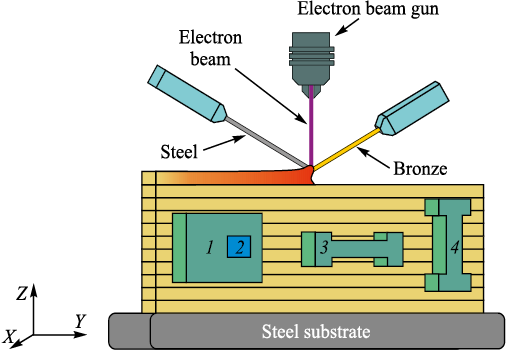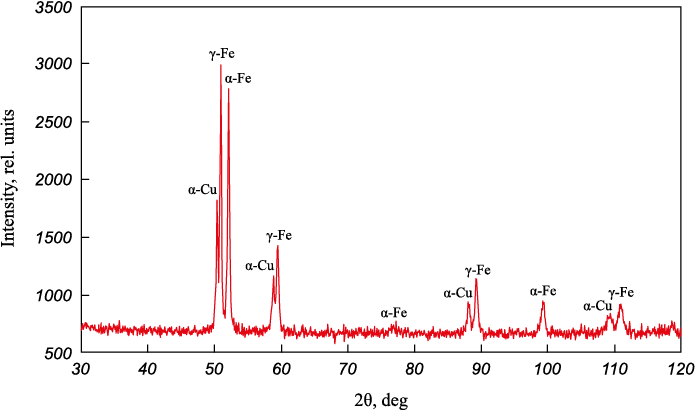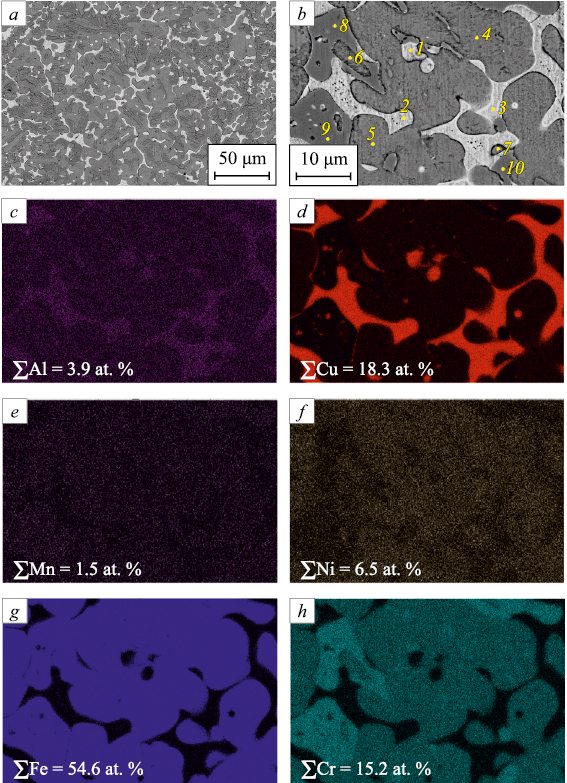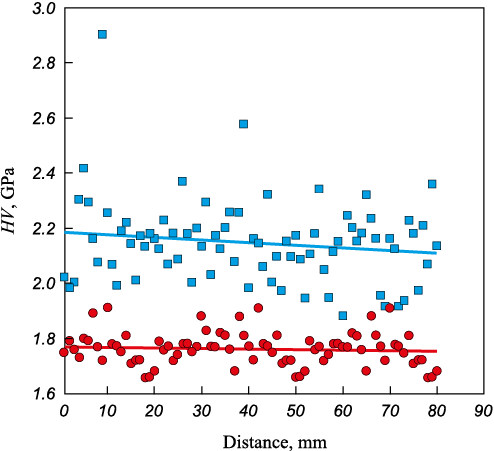Scroll to:
Electron beam additive manufacturing of composite alloy from stainless steel and aluminum bronze: Microstructure and mechanical properties
https://doi.org/10.17073/0368-0797-2023-2-197-205
Abstract
The authors investigated the microstructure, phase composition and mechanical properties of the steel-bronze composite obtained by electron beam additive manufacturing with simultaneous supply of aluminum bronze wires BrAMc9-2 and stainless steel 06Kh18N9T. X-ray diffraction analysis revealed that the composite contains 25 % (vol.) of aluminum bronze, which leads to the formation of a three-phase structure consisting of γ-Fe, α-Fe and α-Cu grains. According to scanning electron microscopy, the volume fraction of austenite, ferrite and bronze in the steel – 25 % bronze composite is 40.7, 35.7 and 23.6 %, respectively. Unstable conditions of the electron beam additive manufacturing process lead to the release of dispersed particles in austenite and ferrite grains. Dispersion-hardened copper particles with an average particle size of 40 nm, the volume fraction of which is 47 %, are isolated in austenite grains. Dispersion-hardened NiAl particles with a volume fraction of 20 % are isolated in ferrite grains, the average size of which is 44 nm. Transmission electron microscopy data indicate the coherent conjugation of arrays of dispersion-hardened particles with the matrix. Such a composite structure provides an increase in yield strength and tensile strength by an average of 400 and 600 MPa compared with yield strength and tensile strength of 06Kh18N9T steel obtained by electron beam additive manufacturing without bronze addition. Microhardness of the composite is on average 2.2 GPa, which is 0.4 GPa higher than that of 06Kh18N9T steel obtained by electron beam additive manufacturing without bronze addition.
Keywords
For citations:
Zykova A.P., Panfilov A.O., Chumaevskii A.V., Vorontsov A.V., Tarasov S.Yu. Electron beam additive manufacturing of composite alloy from stainless steel and aluminum bronze: Microstructure and mechanical properties. Izvestiya. Ferrous Metallurgy. 2023;66(2):197-205. https://doi.org/10.17073/0368-0797-2023-2-197-205
Introduction
Еlectron beam additive manufacturing (EBAM) is a highly efficient and productive method of additive manufacturing (AM) [1 – 3]. This process utilizes metal wire as its source material, which is fed to the focal spot of an electron beam. Upon melting the wire, its drop is transferred into a molten pool formed in a substrate, which then solidifies to form a bead [4]. Unlike the powder-bed AM methods, EBAM may not be suitable for manufacturing complex geometries with small features (up to 1 mm), but it offers several other advantages, such as producing defect-free, high-quality items, that are difficult to obtain with the powder-bed technologies [5; 6]. Furthermore, EBAM is performed under vacuum conditions, which prevent the ingress of inclusions and oxidation, and also eliminate gas porosity in the resulting materials [7 – 9].
Austenitic stainless steel is widely used in various industries, including chemical processes, mechanical engineering, high-temperature bolt fabrication, and nuclear reactors, due to its excellent corrosion resistance, high-temperature mechanical properties, and good manufacturability and weldability. However, the production of complex geometry items with traditional manufacturing methods is both costly and labor-consuming process. The development of AM can significantly simplify the manufacturing of complex geometry items, reduce the production cost, and have a positive impact on the development of various industries. Nevertheless, the wide application of AM is limited by certain challenges, such as occurrence of high-temperature gradients and low cooling rates during the process, which can lead to formation of heterogeneous structure and phase composition [10 – 12]. For instance, an anisotropic structure and mechanical properties of stainless steel items manufactured by selective laser melting are attributed to the high ratio of the molten pool width to the layer thickness [10 – 12], and the presence of unmelted powder particles [13 – 15]. However, these defects can be avoided using direct laser sintering of powdered stainless steel, followed by impregnation with bronze [16; 17]. This technology serves not only to reduce porosity and increase the density of samples, but also to enhance the yields stress and ultimate strength of the items.
The wire-feed EBAM is effective for avoiding the gas porosity. However, there are low cooling rates that can facilitate formation of high aspect ratio columnar grains. Moreover, during the primary crystallization of columnar grains, δ-ferrite grains may form in the interdendritic spaces, which reduce the corrosion resistance of stainless steels [6; 7; 9]. Mechanical properties can be improved either by eliminating the columnar grains or refining them using ultrasonic treatment during EBAM [18]. Such a combined technology can reduce the δ-ferrite content by up to 2 %.
The metallurgical processes involved in either powder-bed or wire-feed AM differ significantly, leading to questions about the structural formation of composites when stainless steel and aluminum bronze are directly added to the molten pool. This study aims to investigate the structural phase state and mechanical properties of a steel-bronze composite produced by electron beam additive manufacturing with simultaneous feeding of two wires.
Experimental
Workpieces of steel – 25 % bronze composite measuring 80×120×8 mm were manufactured using EBAM. The raw materials used were \(\emptyset \)1.6 mm wires made of stainless steel ER321 and aluminum bronze grade CuAl9Mn2. A stainless steel plate with a thickness of 10 mm was used as the substrate. The manufacturing process is illustrated in Fig. 1, which shows the EBAM facility equipped with two wire feeders. The process parameters included a beam accelerating voltage of 30 kV, a beam current that varied between 77 to 44 mA during printing, and a table traveling speed of 400 mm/min. The required percentage of steel and bronze was maintained by automatically adjusting the respective ratio of wire feeding rates, with the feeding rate of ER321 and CuAl9Mn2 wires set at 1300 and 250 mm/min, respectively. Ultimately, the composite was manufactured with a volumetric ratio of stainless steel to bronze of 75:25.
Fig. 1. Deposition path of steel – 25 % bronze composite |
Structural and phase composition analysis, as well as mechanical property evaluation, was conducted on samples cut according to the layout depicted in Fig. 1. The samples of the steel – 25 % bronze composite underwent conventional preparation, including grinding with emery paper (corundum) and polishing with diamond pastes of various grain sizes (14/10, 3/2 and 1/0). To expose microstructure elements, the polished surface of the composite was chemically etched using the following reagent: 30 ml HCl + 5 g FeCl3–6H2O + 60 ml H2O.
The microstructure and chemical composition of the samples were analyzed using a Thermo Fisher Scientific Apreo S LoVac scanning electron microscope equipped with an energy dispersion spectrometer (EDS). The average grain size was determined using the secant method [19], while the phase composition was analyzed using a DRON-7 X-ray diffractometer (CoKα radiation). The microstructural features of the composite were studied using a JEOL-2100 transmission electron microscope. Vickers microhardness was measured using a Duramin 5 hardness meter under a 100 g load with a 1 mm step. Uniaxial tension tests were carried out using an UTS-110M universal testing machine with blades cut off in mutually perpendicular directions according to the layouts in Fig. 1.
Results and discussion
The XRD analysis showed the steel – 25 % bronze composite is composed of γ-Fe, α-Fe and α-Cu (Fig. 2). This allowed us to assume that a portion of austenite was transformed into ferrite as a consequence of fusion of stainless steel and aluminum bronze.
Fig. 2. XRD pattern of steel – 25 % bronze composite |
SEM BSE images revealed the presence of at least three structural components in the composite. (Fig. 3, a, b). Austenite was observed as light grey dendrites (Fig. 3, b), and its elemental composition was proportional to the that of the initial wire, but enriched additionally with up to 6 at. % Al and 8 at. % Cu (Fig. 3, b; Table 1, spectra 4 – 7). The average size of γ-Fe grains is approximately 4.3 μm.
Fig. 3. SEM-BSE images (a, b), EDS element distribution maps (f – h) from section b:
Table 1. EDS spectra of the steel – 25% bronze composite obtained by SEM
| ||||||||||||||||||||||||||||||||||||||||||||||||||||||||||||||||||||||||||||||||||||||||||||||||||||||||||||||||||||||
The light regions in the microstructure corresponded to copper-based solid solution, which was confirmed by the EDS element distribution maps (Fig. 3, b, d). The α-Cu based solid solution contained about 2 at. % Cr, 6 at. % Fe and 5 at. % Ni (Fig. 3, b; Table 1, spectra 1 – 3), and the average size of α-Cu grains was approximately 3.1 μm.
The dark grey regions were located between α-Cu particles and corresponded to an oversaturated solid solution of chromium in α-Fe (Fig. 3, b). The average α-Fe grain size is 3.3 μm, and the particles belonging to ferrite were depleted with nickel to 22.7 at. %. According to SEM data, the volumetric portion of austenite, ferrite and bronze in the steel – 25 % bronze composite was 40.7, 35.7 and 23.6 %, respectively.
The element distribution maps also provide that copper particles are present in the majority of austenite grains (Fig. 3, d), and that nickel atoms exist in the α-Cu regions (Fig. 3, f). Notably, regions with higher concentration of chromium atoms are located at the periphery of austenitic grains, in the vicinity of α-Cu regions (Fig. 3, h), which are also depleted in nickel compared to the main background (Fig. 3, f). Such variations in the chromium nickel equivalent occur as a result of the dissolution of nickel atoms in α-Cu, leading to the formation of a ferrite-based solid solution.
A more detailed SEM analysis was conducted to study the microstructure of the steel – 25 % bronze composite, revealing the existence of NiAl spherical particles within the α-Fe particles (Fig. 4, a – c). The dark field TEM image clearly shows these NiAl particles formed at the ferrite/bronze interface (Fig. 4, c). EDS analysis confirmed the stoichiometric composition of NiAl particles (Fig. 4, a, spectrum 2; Table 2). The average size of NiAl particles within α-Fe was found to be 44 ± 1.4 nm.
Fig. 4. TEM bright-field images of microstructures of as-deposited steel – 25 % bronze (a, d); |
Table 2. EDS spectra of steel – 25% bronze composite obtained by TEM
| Spectrum | Element content, at. % | Assumed phase | |||||||
| Al | Si | Ti | Cr | Mn | Fe | Ni | Cu | ||
| 1 | 5.7 | 1.1 | 1.7 | 20.7 | 0.9 | 57.7 | 6.5 | 5.7 | α-Fe |
| 2 | 41.8 | – | 1.3 | 0.8 | 2.1 | 6.9 | 38.3 | 8.7 | NiAl |
| 3 | 3.8 | 1.4 | – | 16.2 | 1.3 | 61.8 | 7.4 | 8.1 | γ-Fe |
| 4 | 10.7 | – | – | 0.9 | 1.4 | 3.6 | 5.6 | 77.8 | α-Cu |
Furthermore, SAED pattern was obtained from the interlayer between grains of austenite and ferrite that revealed the existence of FCC phase with a lattice constant of a = 3.60 Å, corresponding to both γ-Fe and α-Cu (Fig. 4, e). The high copper content in the analyzed region (Fig. 4, e, spectrum 4; Table 2) suggests that this is a copper-based solid solution enriched with chromium and nickel atoms. A dark field TEM image obtained in the reflection of α-Cu (Fig. 4, f ) shows that there are fine dispersed copper particles in γ-Fe, with an average size of about 40 ± 1.4 nm (Fig. 4, f ). These particles may have formed in γ-Fe due to a decrease in copper solubility and precipitation of copper clusters from the oversaturated γ-Fe solid solution upon cooling.
Fig. 5 illustrates the microhardness profiles on steel grade ER321 and steel – 25 % bronze composite. The microhardness number profile of ER321 steel is stepwise, which is attributed to the presence of a sufficiently high fraction of δ-ferrite and the heterogeneities of the dendrite microstructure [18]. The microhardness of the steel – 25 % bronze composite is, on average, 2.2 ± 0.03 GPa, which is approximately 0.4 GPa higher than that of steel obtained by EBAM without addition of bronze. The higher microhardness (up to 2.9 GPa) of the steel – 25 % bronze composite is attributed to the indenter hitting into austenite grains, while the lower microhardness (down to 2 GPa) corresponds to the indenter hitting into the boundary of ferrite bronze grains (Fig. 5).
Fig. 5. Microhardness distribution profiles for steel ER321 ( |
The mechanical properties of the steel – 25 % bronze composite are presented in Table 3. The yield stress and ultimate strength of the steel, grade ER321, obtained by EBAM without the addition of bronze are approximately 300 and 610 MPa, respectively (Table 3) for comparison purposes. The yield stress and ultimate strength of the steel – 25 % bronze composite increase to 840 ± 42 and 1200 ± 57 MPa, respectively. However, the relative elongation of the composite shows a minor increase compared to that of steel ER321 (Table 3).
Table 3. Mechanical properties of steel ER321
and steel – 25% bronze composite obtained by EBAM
|
Addition of two molten wires into the pool resulted in intermixing and mutual diffusion of both alloys’ components, leading to changes in the nickel chromium equivalent and the formation of grains of α-Fe based solid solution in γ-Fe regions adjacent to α-Cu based solid solution. Additionally, the interdendrite spaces were enriched with chromium, and crystallized as δ-ferrite in cooling. Previous studies have reported such a γ → α-transformation during the manufacturing of steel – bronze composite structures using wire arc additive technology [19; 20].
Conclusions
This study investigates the microstructure and mechanical properties of a composite material produced by fusing 25 vol. % CuAl9Mn2 aluminum bronze with austenitic stainless steel using electron beam additive melting with dual wire feeding. The composite exhibits a three-phase structure, consisting of defect-free austenite, ferrite, and bronze, with the predominant phases being austenite and ferrite. Copper and NiAl particles are present, acting as dispersion hardening precipitates in the ferrite and austenite, respectively. The composite also exhibits higher microhardness (by 0.4 GPa) compared to pure steel produced via EBAM. Moreover, the yield stress and ultimate strength of the composite are increased by an average of 400 MPa and 600 MPa, respectively.
References
1. Stawovy M.T. Comparison of LCAC and PM Mo deposited using Sciaky EBAMTM. International Journal of Refractory Metals and Hard Materials. 2018;73:162–167. https://doi.org/10.1016/j.ijrmhm.2018.02.009
2. Madhavadas V., Srivastava D., Chadha U., Raj S.A., Sultan M.T.H., Shahar F.S., Shah A.U.M. A review on metal additive manufacturing for intricately shaped aerospace components. CIRP Journal of Manufacturing Science and Technology. 2022;39:18–36. https://doi.org/10.1016/j.cirpj.2022.07.005
3. Le V.T., Paris H. Impact of total build height and batch size on environmental performance of electron beam melting. Procedia CIRP. 2018;69:112–117. https://doi.org/10.1016/j.procir.2017.11.013
4. Galati M. Electron beam melting process: A general overview. In: Handbooks in Advanced Manufacturing. Chapter 8. 2021:277–301. https://doi.org/10.1016/B978-0-12-818411-0.00014-8
5. Yin Q., Chen G., Cao H., Zhang G., Zhang B., Wei S. Transformation law of microstructure evolution and mechanical properties of electron beam freeform fabricated 321 austenitic stainless steel. Vacuum. 2021;194:110594. https://doi.org/10.1016/j.vacuum.2021.110594
6. Tarasov S.Yu., Filippov A.V., Shamarin N.N., Fortuna S.V., Maier G.G., Kolubaev E.A. Microstructural evolution and chemical corrosion of electron beam wire-feed additively manufactured AISI 304 stainless steel. Journal of Alloys and Compounds. 2019;803:364–370. https://doi.org/10.1016/j.jallcom.2019.06.246
7. Panin V.E., Narkevich N.A., Durakov V.G., Shulepov I.A. Control of the structure and wear resistance of a carbon-nitrogen austenitic steel coating produced by electron beam cladding. Physical Mesomechanics. 2021;24:53–60. https://doi.org/10.1134/S1029959921010082
8. Zykova A., Nikonov S., Utyaganova V., Shamarin N., Ivanov A., Chumaevskii A. Process control features of electron-beam additive manufacturing of austenitic stainless steel. Procedia Structural Integrity. 2020;30:216–223. https://doi.org/10.1016/j.prostr.2020.12.033
9. Wanjara P., Brochu M., Jahazi M. Electron beam freeforming of stainless steel using solid wire feed. Materials & Design. 2007;28(8):2278–2286. https://doi.org/10.1016/j.matdes.2006.08.008
10. Yadollahi A., Shamsaei N., Thompson S.M., Seely D.W. Effects of process time interval and heat treatment on the mechanical and microstructural properties of direct laser deposited 316L stainless steel. Materials Science and Engineering: A. 2015;644:171–183. https://doi.org/10.1016/j.msea.2015.07.056
11. Suryawanshi J., Prashanth K.G., Ramamurtya U. Mechanical behavior of selective laser melted 316L stainless steel. Materials Science and Engineering: A. 2017;696:113–121. https://doi.org/10.1016/j.msea.2017.04.058
12. Casati R., Lemke J., Vedani M. Microstructure and fracture behavior of 316L austenitic stainless steel produced by selective laser melting. Journal of Materials Science & Technology. 2016;32(8):738–744. https://doi.org/10.1016/j.jmst.2016.06.016
13. Narasimharaju S.R., Zeng W., See T.L., Zhu Z., Scott P., Jiang X., Lou S. A comprehensive review on laser powder bed fusion of steels: Processing, microstructure, defects and control methods, mechanical properties, current challenges and future trends. Journal of Manufacturing Processes. 2022; 75:375–414. https://doi.org/10.1016/j.jmapro.2021.12.033
14. Leo P., D’Ostuni S., Perulli P., Sastre M.A.C., Fernández-Abia A.I., Barreiro J. Analysis of microstructure and defects in 17-4 PH stainless steel sample manufactured by Selective Laser Melting. Procedia Manufacturing. 2019;41:66–73. https://doi.org/10.1016/j.promfg.2019.07.030
15. Cacace S., Demir A.G., Semeraro Q. Densification mechanism for different types of stainless steel powders in Selective Laser Melting. Procedia CIRP. 2017;62:475–480. https://doi.org/10.1016/j.procir.2016.06.010
16. Lu S.L., Meenashisundaram G.K., Wang P., Nai S.M.L., Wei J. The combined influence of elevated pre-sintering and subsequent bronze infiltration on the microstructures and mechanical properties of 420 stainless steel additively manufactured via binder jet printing. Additive Manufacturing. 2020;34: 10126. https://doi.org/10.1016/j.addma.2020.101266
17. Pavankumar G., Elangovan M. Study on effect of post processing on Direct Metal LASER sintered 420 stainless steel infiltrated with bronze. Materials Today: Proceedings. 2018; 5(11):Part 3:24476–24485. https://doi.org/10.1016/j.matpr.2018.10.244
18. Vorontsov A., Astafurov S., Melnikov E., Moskvina V., Kolubaev E., Astafurova E. The microstructure, phase composition and tensile properties of austenitic stainless steel in a wire-feed electron beam melting combined with ultrasonic vibration. Materials Science and Engineering: A. 2021;820: 141519. https://doi.org/10.1016/j.msea.2021.141519
19. Gol’dshtein M.I., Litvinov V.S., Bronfin B.M. Metallophysics of High-Strength Alloys. Moscow: Metallurgiya; 1986: 312. (In Russ.).
20. Kucita P., Wang S.C., Li W.S., Cook R.B., Starink M.J. The effects of substrate dilution on the microstructure and wear resistance of PTA Cu–Al–Fe aluminium bronze coatings. Wear. 2019;440–441:203102. https://doi.org/10.1016/j.wear.2019.203102
21. Tao X.P., Zhang S., Zhang C.H., Wu C.L., Chen J., Abdullah A.O. Effect of Fe and Ni contents on microstructure and wear resistance of aluminum bronze coatings on 316 stainless steel by laser cladding. Surface and Coatings Technology. 2018;342:76–84. https://doi.org/10.1016/j.surfcoat.2018.02.032
About the Authors
A. P. ZykovaRussian Federation
Anna P. Zykova, Cand. Sci. (Phys.-Math.), Senior Researcher, Head of the Laboratory of Structural Design of Advanced Materials
2/4 Akademicheskii Ave., Tomsk 634055, Russian Federation
A. O. Panfilov
Russian Federation
Aleksandr O. Panfilov, Postgraduate, Junior Researcher of the Laboratory of Structural Design of Advanced Materials
2/4 Akademicheskii Ave., Tomsk 634055, Russian Federation
A. V. Chumaevskii
Russian Federation
Andrei V. Chumaevskii, Cand. Sci. (Eng.), Senior Researcher of the Laboratory of Local Metallurgy in Additive Technologies
2/4 Akademicheskii Ave., Tomsk 634055, Russian Federation
A. V. Vorontsov
Russian Federation
Andrei V. Vorontsov, Cand. Sci. (Eng.), Research Associate of the Laboratory of Local Metallurgy in Additive Technologies
2/4 Akademicheskii Ave., Tomsk 634055, Russian Federation
S. Yu. Tarasov
Russian Federation
Sergei Yu. Tarasov, Dr. Sci. (Eng.), Chief Researcher of the Laboratory of Physics of Surface Hardening
2/4 Akademicheskii Ave., Tomsk 634055, Russian Federation
Review
For citations:
Zykova A.P., Panfilov A.O., Chumaevskii A.V., Vorontsov A.V., Tarasov S.Yu. Electron beam additive manufacturing of composite alloy from stainless steel and aluminum bronze: Microstructure and mechanical properties. Izvestiya. Ferrous Metallurgy. 2023;66(2):197-205. https://doi.org/10.17073/0368-0797-2023-2-197-205






































